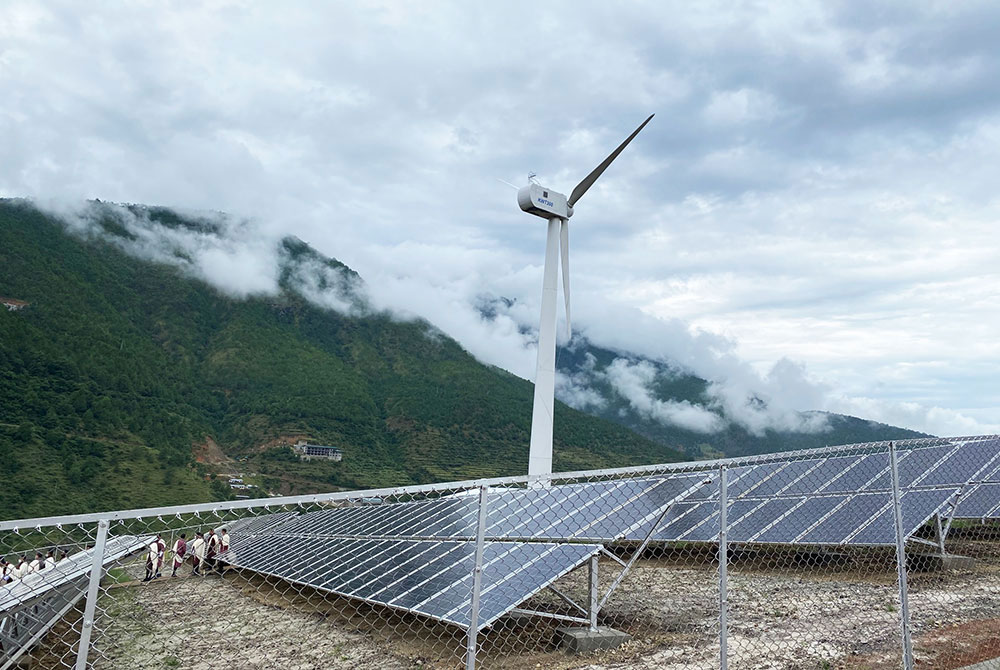Low renewable energy share in total energy consumption
Yangyel Lhaden
To increase the share of renewable energy (RE) in the total energy mix— individual contribution of energy from various sources, the Department of Energy (DoE) is set to initiate 500 megawatts (MW) of RE projects across the country in the next five years.
This in light of an expected rise in energy demand, projected to peak more than 25,270.giga-watt per hour (GWh) in 2030, up from the current 5,000 GWh, last year.
How would 500 MW add to the energy demand?
Electricity today makes up only 37.6 percent of total energy consumption—electricity and thermal— while energy from alternative renewables such as solar and wind remained below one percent of total energy consumption, according to Bhutan Energy Data Directory (BEDD) 2022.
In 2022, the country consumed 793,363 tons of oil equivalent (TOE) energy. With one GWh equivalent to 85.98 TOE, 500 MW has the potential to contributeabout 53,000 TOE energy in a year to the total energy demand.
TOE is a unit used to compare different energy sources based on their energy content.
The country has a potential to harness 12-gigawatt solar energy and 760 MW wind energy and has an installed capacity of 2,335MW, which is 7 percent of the country’s total hydropower potential.
Today, Rubesa Wangdue has a 600-kW (kilowatt) wind farm and a 180-kW solar farm. Aja Ney, Mongar, has an 80-kilowatt peak (kWp) decentralised distribution generation powered by solar. There is also a 5 kWp solar plant in Mendrelthang, Lunana and a 17.3-megawatt peak solar farm is being installed in Sephu.
However, the country’s energy supply still leans heavily on thermal sources like biomass, petroleum, coal and their derivatives.
Thermal energy sources like biomass which mainly consist of fuel wood for cooking and heating, petroleum, coal, and their derivatives accounted for a substantial 62.4 percent of total energy consumption last year.
“The use of thermal energy is more prevalent than the use of electricity because thermal energy is employed in all sectors, including buildings, transportation, and industry,” a DoE official said. “ Compared with 2014, overall energy consumption has increased in 2022 due to population growth, increased commercial activities, transportation and industrial expansion.”
Energy consumption increased from 650,220 TOE in 2014 to 752,441 TOE in 2022.
However, the energy data report highlighted a positive trend of reduced energy consumption in both the building and transport sectors compared its 2015 report, particularly noting the contribution of alternative renewable energy sources.
The comparison of energy consumption data between 2014 and 2022 for petroleum, coal and derivatives, and biomass shows a shift in the energy mix.
The building sector’s energy consumption dropped by over half last year, amounting to 154,176 TOE, compared to 2015. Additionally, the building sector’s biomass consumption was markedly lower, standing at 97,750 TOE in contrast to the 234,369 TOE recorded in 2014.
“While it is challenging to replace fossil fuels which are extensively used in sectors like building, transport, and industry, many initiatives are emerging to increase the adoption of renewable energy,” a DoE official said.
Moreover, since households currently benefit from a very low electricity tariff of Nu 2.66, with an additional 100 units provided free for rural households, other RE projects become comparatively expensive for households to adopt, the official said. “ This results in a low share of alternative renewable energy generation.”
What makes the energy mix
Within the energy mix, electricity constituted the largest portion of the total energy consumption, comprising 37.6 percent although thermal energy constituted the highest share in total energy consumption last year,followed by biomass at 25.2 percent, equivalent to 199,955.8 TOE, and coal and its derivatives at 19.6 percent totalling 155,699.5 TOE. Petroleum products represented 17.6 percent with 139,589.2 TOE, while electricity from alternative renewables such as solar and wind remained below one percent, according to BEDD 2022.
Comparing these figures to the 2015 energy data, in 2014, biomass dominated the energy mix, accounting for 234,369 TOE or 36 percent of total energy consumption while electricity contributed 28 percent or 182,092 TOE to the total energy consumption.
To increase the share of alternative energy in the total energy mix, the department is exploring various opportunities, including green hydrogen. They are also promoting the diversification of energy sources in the overall supply mix, which involves grid integration of other energy systems like solar, wind, and biomass, as well as the promotion of energy-efficient equipment for industries, among other initiatives.
“There are many initiatives that are coming up such as clean cooking project to reduce the use of liquefied petroleum gas and fuel wood and promotion of electric vehicles which is aimed to reduce dependence on fossil,” the DoE official said.


